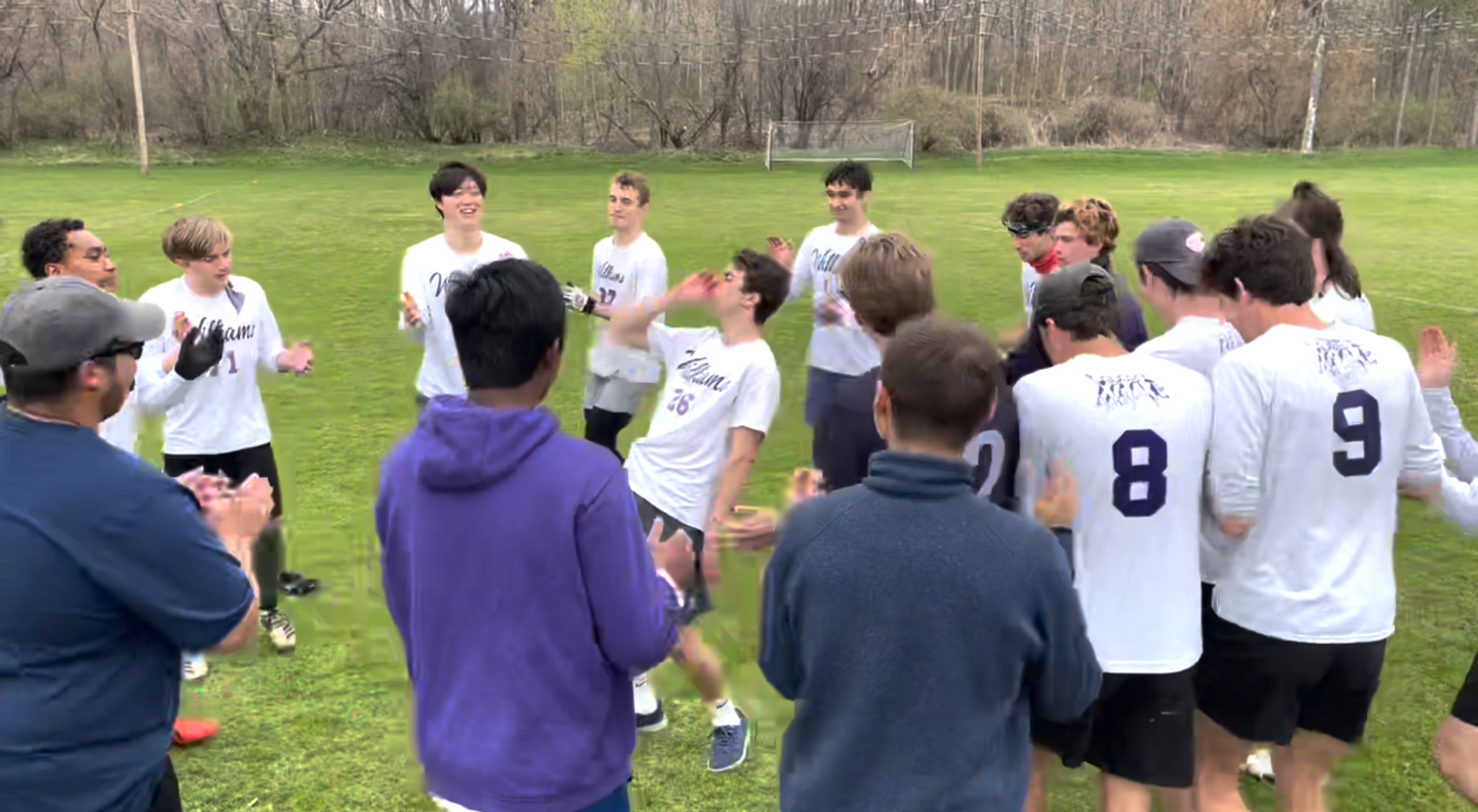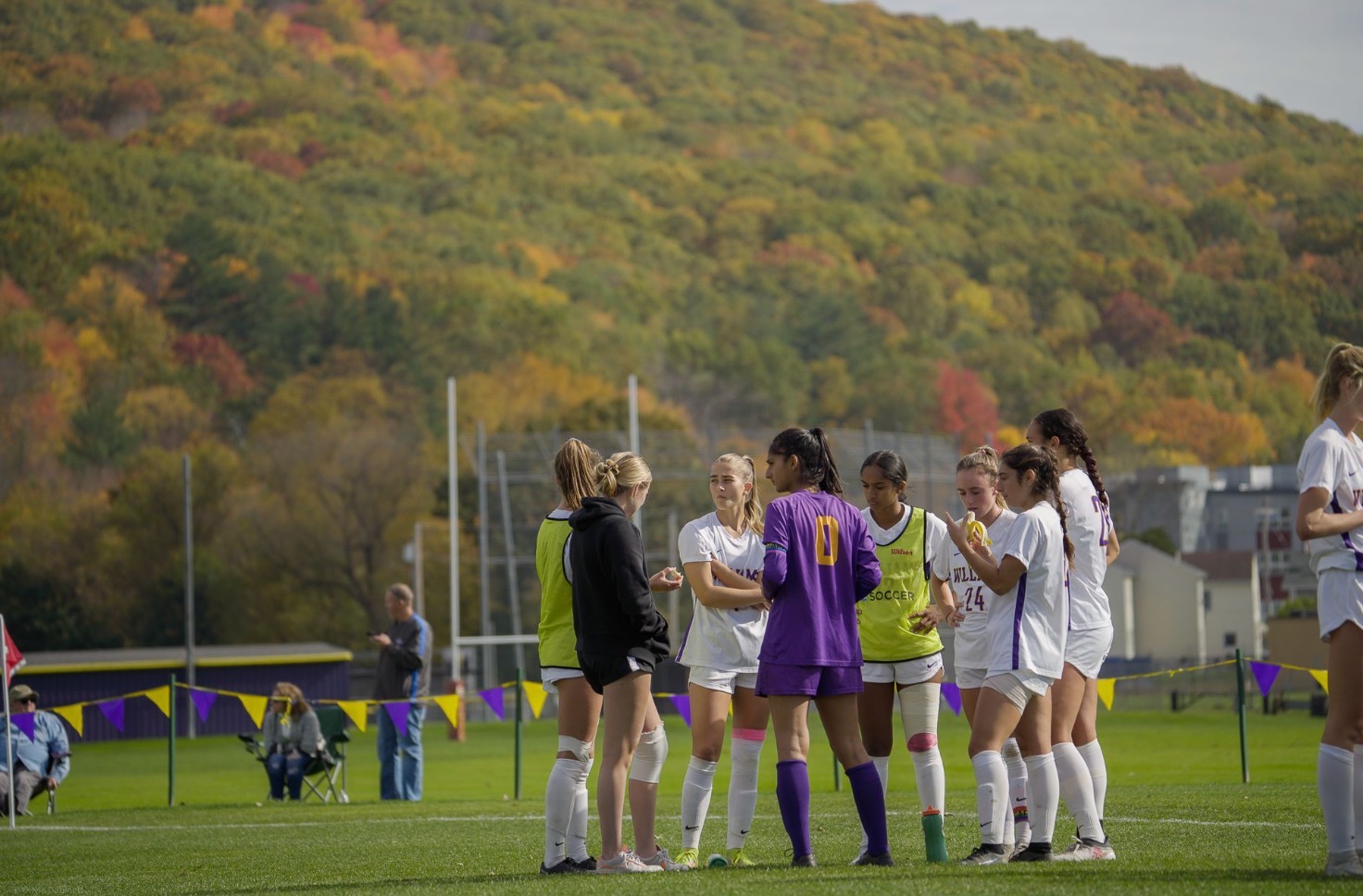Pre-game songs and mid-game cheers: Ultimate frisbee and women’s soccer talk team traditions
November 9, 2022
Athletes are no strangers to traditions. From superstitions before games to bonding rites, these customs can tie together a sporting community and inspire devotion amongst fans and players.In the second article of a two-part series, the Record spoke with Williams Ultimate Frisbee Organization (WUFO) and the women’s soccer team about the traditions that foster a sense of camaraderie.
WUFO

The sounds on Cole Field during WUFO’s practices are varied: the wind whistling through the trees, the pounding footsteps of 30 leggings-and-shorts-clad players hurtling at flying pieces of plastic across the field, the thunks of said pieces of plastic hitting a palm, and, perhaps most peculiarly, the aforementioned 30- some players chanting:
“SUGAR, WATER, [pause] PURPLE.”
Cheers at practices and tournaments have long been a tradition representative of WUFO culture, and, beyond that, ultimate frisbee culture as a whole. The quirkier they are, the better, according to Jonah Tobin ’23, a cocaptain of WUFO. Perennial favorites of his range from off-beat remixes of hip hop songs to chanting “STRONG LIKE BULL. SMART LIKE TRACTOR,” to a dual effort with the opposing team shouting “NO, YOU HANG UP” back at each other.
There’s little rhyme or reason to the actual words they chant — “Sugar, Water, Purple” was derived from a comedy bit over 20 years ago — but the meaning comes from the act of performing the cheer as a team. “We play our best when we’re smiling and enjoying each other,” Tobin said. “Obviously it’s fun to win, but the cheers just get us to be happy and excited to be with each other.”
The longevity of the cheers serves as proof of their popularity among the team. Across the decadeslong landscape of WUFO’s sideline cheering, ultimate teams from a variety of colleges have even been able to memorize and repeat WUFO’s cheers and vice versa. “We go play other teams across the Northeast who will then do our cheers back to us because they’ve picked them up over the years,” Tobin said. “[Doing that] is like, ‘We love you guys, we enjoy playing against you.’”
With the emphasis ultimate frisbee places on community, it’s no wonder that alums remain committed to and integrated within the team after graduating. Every year, the College hosts the Purple Valley Tournament — the longest-running college frisbee tournament in the country — where alums return to the Purple Valley, form a team, and play in the tournament.
The tournament and other alum events allow members of the team to become quite close with alums, even ones that never overlapped with their time here. Talking with alums that return long after they’ve graduated also allows the team to learn about traditions from years prior and even revive some, Tobin said. “Seeing the alums’ excitement about WUFO with them coming back after being here and the importance that this community has [to them] really makes me want to dive more into it and give it my best,” he said.
But according to Tobin, the current team’s deep involvement with alums can cause tension. “Sometimes alums want to view the community as they experienced it,” he said. “So there are sometimes competing interests there.”
With a constant revolving door of athletes graduating from and entering the team, a uniform team culture — and, with it, traditions — that appeals to both current and former members becomes difficult to reconcile. “Traditions are one of the hardest things to balance, because as the team changes culture-wise, sometimes the traditions feel out of place,” Tobin said. “We’ve also tried to think about making new traditions or making new cheers that hopefully are fun for everybody there.”
Women’s soccer

Church is an integral part of the women’s soccer team. The song “Church” by TPain, that is. Two minutes before each game, the team gathers in a circle, plays the song, and dances along on the field — with coordinated dance moves and claps — as a pregame hype-up. “It kind of gets your mind out of the nerves and stress for the game and shows that, at the end of the day, we all want to be enjoying what we’re doing,” midfielder Shae Rashoff ’24 said.
“Church,” along with the four songs that the team sings together in the locker room before games, is a tradition that differs vastly from her pregame experience playing on a club team in high school, she said. “In club, it was ‘I’m getting ready as an individual to go out and play my best,’ and this feels more like we’re all going out there as a collective,” she said.
Since many players are striving for recruitment in high school soccer, the experience was a lot more individual, Rashoff said, whereas at the College, the women’s soccer team is working toward a common goal to perform well together as a team. “[Playing soccer at the College] feels a lot more like a family and feels more like we’re playing for each other,” she said.
The pregame singing and dancing traditions are certainly a contributor to the community-building that the team emphasizes, according to Rashoff. Though the tradition required her to change from a more individual pregame routine to a team-based one, she’s grown to love it. After hearing the same songs before each game and performing the same routine with her team, it eventually became easy to associate the songs themselves with the adrenaline and excitement of being with her team before games.
“[That feeling] kind of clicks for you,” she said. “Now, I wouldn’t ever go back.”








